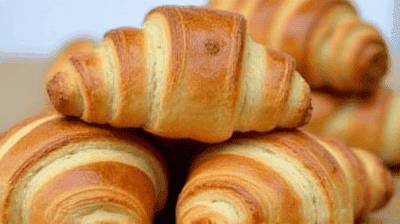
Are you tired of settling for store-bought croissants that just don't hit the spot? Why not try making your own buttery croissants from scratch at home? Not only will you be able to customize the flavor to your liking, but the satisfaction of biting into a freshly baked homemade croissant is unbeatable.
In this article, we'll guide you through the process of making perfect buttery croissants from scratch. We'll cover everything from the key ingredients required to the step-by-step process of making the flaky pastry. We'll also provide tips for perfecting your croissants, baking and serving suggestions, and troubleshooting common problems.
If you've ever tasted a homemade croissant, you know why they are worth the effort. These delicious breakfast pastries are a world away from their store-bought counterparts, with a flaky buttery texture and a delicate sweetness that make them the perfect indulgence.
The beauty of making homemade croissants is not just in the superior taste, but also in the satisfaction of creating something with your own hands. There's a joy in baking that can't be replicated by anything store-bought.
Here are some specific reasons why taking the time to make your own croissants is worth it:
So if you're looking for a new baking challenge or just want to treat yourself to something special, homemade croissants are definitely worth the effort.

If you want to achieve that perfect buttery pastry texture, it's important to use high-quality ingredients. Here are the key ingredients you'll need:
| Ingredient | Description |
|---|---|
| All-purpose flour | Provides structure and texture to the croissant dough |
| Instant yeast | Helps the dough rise quickly and evenly |
| Water | Binds the ingredients together and activates the yeast |
| Sugar | Provides flavor and helps activate the yeast |
| Salt | Enhances flavor and helps control the yeast growth |
| Butter | Provides the rich, buttery flavor and creates those signature layers in the croissant |
When selecting ingredients, opt for high-quality butter with a high percentage of fat. European-style butter is a great option for achieving that classic croissant flavor.
Another important aspect of making buttery croissants is temperature control. Keep all ingredients, particularly the butter, cold throughout the process to ensure the layers remain distinct and the croissants come out flaky and delicious.
When it comes to handling the dough, it's important not to overwork it or the croissants can become tough and dense. Handle the dough gently and follow the recipe closely for best results.
Homemade croissants may seem daunting, but they are well worth the effort. Follow these step-by-step instructions to create delicious, flaky croissants from scratch.
To begin, you'll need to create the dough for the croissants:
The key to flaky croissants is the butter lamination process. Follow these steps to achieve delicious, buttery pastry:
Once your dough has been laminated, it's time to shape and bake your croissants:
Remove from the oven and let cool slightly before enjoying your delicious, flaky croissants!

Now that you have your dough and butter layers (feuilletage) ready, it's time to begin shaping your croissants. Here are a few tips to help you achieve the perfect flaky pastry:
Once you have your croissants shaped, they are ready for the oven. Here are a few additional tips to help you perfect your homemade croissants:
With a little practice and patience, you'll soon be making perfect buttery croissants from scratch. Bon appétit!
Now that you have made your delicious homemade croissants, it's time to bake and serve them to enjoy their buttery goodness.
Preheat the oven to 400°F and place the croissants on a baking sheet lined with parchment paper. Bake for 15-20 minutes, or until the croissants are golden brown and flaky.
For an extra crispy crust, brush the croissants with an egg wash made of one beaten egg and a tablespoon of water before putting them in the oven.
Serve your buttery croissants warm with a side of jam or butter for an indulgent breakfast or brunch. They also make a great addition to a cheese board or charcuterie platter.
If you have any leftover croissants, store them in an airtight container at room temperature for up to two days. To reheat, simply place them in a preheated oven at 350°F for 5-10 minutes, or until heated through.

Now that your homemade croissants are ready to be baked, preheat the oven to 375°F (190°C). Place the croissants on a baking sheet lined with parchment paper and allow them to rest for about 20-30 minutes to rise slightly before baking.
Bake the croissants for approximately 15-20 minutes or until golden brown. Remember to rotate the baking sheet halfway through for even cooking.
For an extra shiny and crunchy crust, brush the croissants with an egg wash (1 egg yolk mixed with 1 tablespoon of milk) before placing them in the oven. You can also sprinkle some sugar on top for added sweetness.
Once the croissants are done baking, remove them from the oven and let them cool for a few minutes before serving. Enjoy your delicious breakfast pastries warm with a cup of coffee or tea.
As for storing any leftover croissants, wrap them tightly in plastic wrap or aluminum foil and keep them at room temperature for up to 2 days. Alternatively, you can freeze the croissants for later use. Just make sure to wrap them in several layers of plastic wrap and place them in a freezer-safe bag or container. Frozen croissants can be reheated in a 350°F (175°C) oven for about 10-15 minutes or until heated through.
Making croissants from scratch can be a challenging yet rewarding experience. However, it's not uncommon to encounter certain issues along the way. Here are some common problems you may encounter and tips for troubleshooting them:
If your dough doesn't rise, it could be due to a few factors. Check the expiration date of your yeast and ensure that your water temperature is within the recommended range. Additionally, make sure your dough has enough time to rise in a warm, draft-free area.
If your croissants have uneven layers, it's likely due to improper rolling and folding techniques. Be sure to roll the dough evenly and distribute the butter evenly during the lamination process. Additionally, make sure your dough stays cold and doesn't become too warm during the rolling and folding stages.
If your croissants are too dense or greasy, it could be due to overworking the dough or using too much butter. Be sure to follow the recipe closely and avoid excessive handling of the dough. Additionally, make sure your butter is of high quality and not melted or too soft when laminating.
Here are some common questions people ask about making buttery croissants from scratch:
Making buttery croissants from scratch at home may seem like a daunting task, but the end result is worth it. The satisfaction of pulling fresh, flaky croissants out of your own oven is unbeatable.
Remember to use high-quality ingredients, follow proper techniques, and take your time. Don't be discouraged if your first batch isn't perfect – practice makes perfect!
We hope this article has inspired you to try making homemade croissants. Share your experiences in the comments section below. Did you run into any challenges? Have any tips to share? We'd love to hear from you!
Thank you for reading and happy baking!